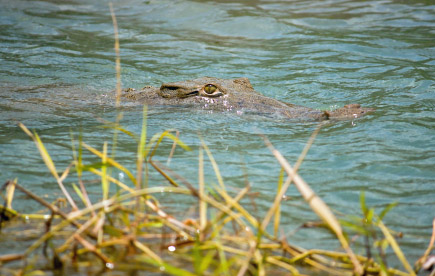How do Crocodiles Swim?
Psst! Crocodiles have their own swimming secret!
While it is common to understand the swimming habits of ocean life, not too many people realize that crocodiles can fall in the category of a natural swimmer. Usually, people think of the crocodile as a bad swimmer at best. This is because of their poor eyesight and the belief that they stay on river banks and tend to wade when they aren’t traveling across land.
What you will find is that there are plenty of different types of crocodiles out there and some that live in the South Pacific islands have been known to actually go long distances across the ocean with little trouble. These creatures tend to take the approach of swimming in a manner that is similar to that of a surfer. With their body balanced on the water, they begin to swim in large strokes as they go across the water. They actually are known to "catch the wave" just like surfers do, and they cross thousands of miles ocean riding the waves.
Crocodiles have also been shown to tuck their feet in while they are swimming and make broad side to side movements to gain momentum while keeping their balance. This helps them to go shorter distances faster and it is the common approach they take when attacking prey.
These creatures also make an impact as they swim as well. Some crocodiles have been shown to grow almost 24 feet long and weigh in excess of 2,200 pounds. This makes these large creatures far more dangerous than the sharks that they have been known to eat. However, the majority of the food that they end up consuming comes from land. Along with this, the crocodile will actually consume fresh water when it is thirsty, rather than the salt water that it lives in.
While on land, the female will nest as well. Typically, the female will lay anywhere from 40 -60 eggs and will hide her eggs in the brush. She will then keep an eye on these eggs until they hatch. Once they are born, she will dig up the nest and carry her young to the water on her back until they are able to swim on their own.
Since they do spend a majority of their time in salt water, some will consider them to be ocean life rather than a creature on the land. While they have been shown to spend a considerable amount of time in the salt waters of the ocean, but since they can withstand long periods of time outside of the water without drying out and dying, it isn’t classified typically a marine life.
With a number of different species of crocodiles out there, you will find that this natural swimmer is one that people will fear and respect. Since their diet consists largely of fish and land animals, they are listed as a predator. Must work for them because they get their proper nutrients where us humans have to really understand where our nutrients come from to let us be natural healthy. What they consume will often vary based on the prey that is readily available to them. This is usually any animal that will come into their range of attack when they are hungry. Because of this, one should keep a safe distance should they experience one of these beautiful animals in their natural habitat.
Today's Daily Swimming Practice:
Warm-up: 500 alternating butterfly drills and freestyle swim
6 X (125 backstroke, 75 freestyle, 50 backstroke, 25 freestyle)
Drill: 6 X 50 butterfly
6 X (125 breaststroke, 75 freestyle, 50 breaststroke, 25 freestyle)
Warm-down: 200 super-slow tai chi style freestyle
Total: 4300 meters or yards depending on length of pool
back to the top of crocodiles page
from crocodiles page to ocean life page .
Don't just build a website, build a web business!
Beauty is just a click away! Visit me, your Independent Beauty Consultant.








